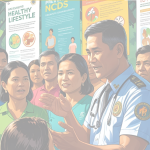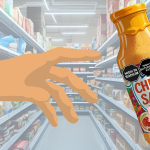
Health advocates push for independent health promotion body to combat NCDs
August 19, 2025PRESS RELEASE
Sept 1, 2025
Our government should impose higher taxes on unhealthy packaged food as another bold and effective policy to combat noncommunicable diseases (NCDs), emphasized the Healthy Philippines Alliance (HPA), a network of public health advocates convened by HealthJustice Philippines, at the height of the upcoming UN High Level Meeting on the Prevention and Control of NCDs and Promotion of Mental Health in September.
The HPA cited findings of a recent modeling study published by the Johns Hopkins University and the DOST-Food and Nutrition Research Institute (FNRI), which revealed that implementing a tax on unhealthy packaged food that exceed sugar and sodium thresholds could significantly reduce sugar and sodium consumption. The study projected that a nutrient-based unhealthy food taxation could lead to thousands of prevented deaths and cases of cardiovascular disease and diabetes, substantial health care savings and tax revenues in the Philippines and promote health gains among middle-income groups.
“We urge our government leaders to act now. Take the lead to prevent NCDs with powerful policies like front-of-package food warning labels paired with a tax system that can discourage the overconsumption of products high in sugar, sodium, and saturated fat. This is not just a tax—it is an investment to protect public health, save lives and build a healthier future for all Filipinos,” said Dr. Jaime Galvez Tan, former Health Secretary and Lead Convenor of the HPA.
Galvez Tan further added, “We are backed by research that shows taxing unhealthy packaged food and beverages can reduce the burden of NCDs, encourage healthier food choices, and generate vital revenue that can be reinvested into our Universal Health Care system and other nutrition programs.”
The HPA also emphasized that implementing a nutrient-based tax model will require a robust Nutrient Profile Model. Therefore, it is essential for the National Nutrition Council to establish the Philippine Nutrient Profile Model as soon as possible to support more comprehensive and targeted taxation of products.
Moreover, the study specifically reported that, in a span of 20 years, a 20% tax on unhealthy packaged food was projected to stop 2,700 deaths, as well as 13,600 ischaemic heart cases, 5,000 strokes, and 21,700 type 2 diabetes.
Tax implementation proved to be cost-effective and cost-saving because an investment of Php 13 billion ($253 million USD) was estimated to generate Php 2.37 billion ($46 million USD) in health-care savings and close to Php 648 billion ($13 billion USD) in tax revenues.
“Food taxes are often misunderstood as anti-poor. But what is truly anti-poor is forcing families to bear the heavy cost of preventable disease caused by cheap, unhealthy food. In fact, more and more Filipinos are dying prematurely due to NCDs,” stated Atty. Faith Laperal, Executive Director of HealthJustice.
Laperal expounded further, “Ultimately, the tax can reduce sugar intake by 7% or 3.8g a day and sodium intake by 10% or 100mg a day in the Filipino diet by the 20th year. This means more lives protected, deaths prevented, and cases of heart disease and type 2 diabetes reduced. Including foods high in saturated fat could lead to even greater health and economic impacts.”
Moreover, the HPA’s Ms. Jofti Villena, Policy Analyst and Board of Trustee of The Policy Center, stood behind the research findings and stated that “A tax on unhealthy food has the potential to significantly reduce poor diets, a leading driver of NCDs. Our government should help reshape our food environment so that it becomes much easier for Filipinos to choose healthier alternatives. Such a policy should also go hand-in-hand with other food policies to strengthen the accessibility of healthier food, like fresh produce from our farmers.”
Villena continued, “We commend the legislators who have filed bills aimed at improving food security, and we urge broad support for these measures to help all Filipinos, especially vulnerable sectors, gain access to whole, nutrient-dense foods rather than relying mainly on convenient ultra-processed food like instant noodles and 3-in-1 coffee.”
The study also revealed that middle-income groups would benefit the most from the proposed tax, gaining the highest number of health-adjusted life years—longer years lived in full health. High-income groups were projected to bear the largest share of the tax burden while achieving larger sodium reductions. Meanwhile, low income groups were projected to experience larger sugar reduction. The Alliance underscores the need for earmarked revenues from the tax to be reinvested for targeted nutrition interventions particularly for the underserved communities.
END




